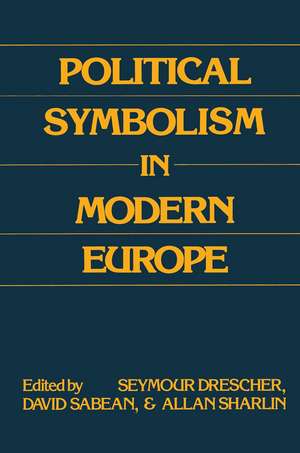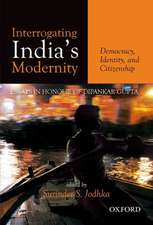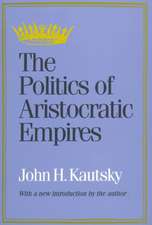Political Symbolism in Modern Europe: Essays in Honour of George L.Mosse
Editat de Seymour Drescheren Limba Engleză Hardback – 31 mai 1982
The essays in the volume deal with: George Mosse and political symbolism; the medical model of cultural crisis in fin de siecle France; cultural uses of "fatigue" in the nineteenth century; Mar-burg neo-Kantian thought and German popular culture; the Ostjude as a cultural symbol in German anti-Semitism; the func-tion of myth and symbol in Georges Sorel; feminism and eugenics in Edwardian England; Darwinism and the working class in Germany; science and religion in early modern Europe; popular theater and socialism in fin de siecle France; political symbolism in the paintings of the German war of liberation; generational discourse in pre-World War I France; and cultural implications of national-socialist religion.
| Toate formatele și edițiile | Preț | Express |
|---|---|---|
| Paperback (1) | 441.84 lei 6-8 săpt. | |
| Taylor & Francis – 18 dec 2020 | 441.84 lei 6-8 săpt. | |
| Hardback (1) | 769.55 lei 6-8 săpt. | |
| Taylor & Francis – 31 mai 1982 | 769.55 lei 6-8 săpt. |
Preț: 769.55 lei
Preț vechi: 1030.55 lei
-25% Nou
Puncte Express: 1154
Preț estimativ în valută:
147.26€ • 157.46$ • 122.78£
147.26€ • 157.46$ • 122.78£
Carte tipărită la comandă
Livrare economică 18 aprilie-02 mai
Preluare comenzi: 021 569.72.76
Specificații
ISBN-13: 9780878554225
ISBN-10: 087855422X
Pagini: 318
Dimensiuni: 152 x 229 mm
Greutate: 0.75 kg
Ediția:1
Editura: Taylor & Francis
Colecția Routledge
Locul publicării:Oxford, United Kingdom
ISBN-10: 087855422X
Pagini: 318
Dimensiuni: 152 x 229 mm
Greutate: 0.75 kg
Ediția:1
Editura: Taylor & Francis
Colecția Routledge
Locul publicării:Oxford, United Kingdom
Cuprins
Acknowledgments -- Introduction: George Mosse and Political Symbolism -- Seymour Drescher, David Sabean, and Allan Sharlin -- Part I: The Language of Cultural Crisis -- 1. Degeneration and the Medical Model of Cultural Crisis -- in the French Belle Epoque -- Robert A. Nye -- 2. The Body without Fatigue: A Nineteenth-Century Utopia -- Anson Rabinbach -- 3. Practical Reason in Wilhelmian Germany: Marburg -- Neo-Kantian Thought in Popular Culture -- Tim Keck -- 4. Caftan and Cravat: The Ostjude as a Cultural Symbol in -- the Development of German Anti-Semitism -- Steven E. Aschheim -- 5. Myth and Symbol in Georges Sorel -- David Gross -- Part II: Science, Myth, and Ideology -- 6. Feminism, Fertility, and Eugenics in Victorian and -- Edwardian England -- Richard Allen Soloway -- 7. Darwinism and the Working Class in Wilhelmian Germany -- Alfred H. Kelly -- 8. Science and Religion in Early Modern Europe -- H. G. Koenigsberger -- Part III: Political Discourse and Cultural Symbols -- 9. Popular Theater and Socialism in -- Late-Nineteenth-Century France -- Joan Wallach Scott -- 10. Dashed Hopes: On the Painting of the Wars of Liberation -- Jost Hermand -- Photo essay.
Descriere
By collectively concentrating on the theme of political symbolism in modern Europe, the con-tributors to this volume have cho-sen to honor a revered teacher and colleague by developing a set of variations on one of his primary scholarly concerns



















